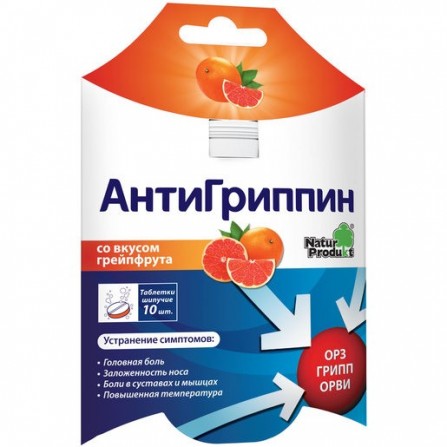Antigrippine effervescent pills with grapefruit flavor 10 pcs
Condition: New product
1000 Items
Rating:
Be the first to write a review!

More info
Active ingredients
Paracetamol + Chlorphenamine + Ascorbic Acid
Release form
Pills
Composition
Paracetamol 500 mg, chlorphenamine maleate 10 mg, ascorbic acid 200 mg.
Pharmacological effect
Combined drug. Paracetamol has an analgesic and antipyretic effect; eliminates headache and other types of pain, reduces fever. Ascorbic acid (vitamin C) is involved in the regulation of redox processes, carbohydrate metabolism, increases body resistance. Chlorphenamine is an H1-histamine receptor blocker, has anti-allergic effect, eases breathing through the nose, reduces feeling of nasal congestion, sneezing, tearing, itching, and redness of the eyes.
Pharmacokinetics
Data on the pharmacokinetics of the drug is not provided.
Indications
Infectious and inflammatory diseases (ARVI, influenza), accompanied by fever, chills, headache, pain in the joints and muscles, nasal congestion and sore throat and sinuses.
Contraindications
Hypersensitivity to paracetamol, ascorbic acid, chlorphenamine or any other component of the drug; erosive and ulcerative lesions of the gastrointestinal tract (in the acute phase); severe renal and / or liver failure; alcoholism; angle-closure glaucoma; phenylketonuria; prostatic hyperplasia; children's age (up to 15 years); Pregnancy and lactation period. With caution - renal and / or liver failure, deficiency of glucose-6-phosphate dehydrogenase, congenital hyperbilirubinemia (Gilbert, Dubin-Johnson and Rotor syndrome), viral hepatitis, alcoholic hepatitis, old age.
Precautionary measures
Do not exceed the recommended doses. With caution: renal and / or liver failure, deficiency of glucose-6-phosphate dehydrogenase, congenital hyperbilirubinemia (Gilbert, Dubin-Johnson and Rotor syndromes), viral hepatitis, alcoholic hepatitis, elderly age.
Use during pregnancy and lactation
Contraindicated during pregnancy and lactation.
Dosage and administration
Inside Adults and children over 15 years old 1 tablet 2-3 times a day.The tablet should be completely dissolved in a glass (200 ml) of warm water (50-60 ° C) and immediately drink the resulting solution. It is better to take the drug between meals. The maximum daily dose is 3 pills. The interval between doses of the drug should be at least 4 hours. In patients with impaired liver or kidney function and in elderly patients, the interval between doses of the drug should be at least 8 hours.
Side effects
The drug is well tolerated in the recommended doses. In isolated cases, there are: from the CNS: headache, fatigue, from the gastrointestinal tract: nausea, epigastric pain; from the endocrine system: hypoglycemia (up to the development of coma); from the blood-forming organs : anemia, hemolytic anemia (especially for patients with deficiency of glucose-6-phosphate dehydrogenase); extremely rare - thrombocytopenia; allergic reactions: skin rash, itching, urticaria, angioedema; others: hypervitaminosis, metabolic disorders, feeling hot, dry mouth, accommodation paresis, urinary retention, drowsiness.
Overdose
Symptoms of an overdose of the drug due to its constituent substances. The clinical picture of acute overdose with paracetamol develops within 6-14 hours after taking it. Symptoms of chronic overdose occur 2-4 days after overdose. Symptoms of acute intoxication with paracetamol: diarrhea, loss of appetite, nausea and vomiting, abdominal discomfort and / or abdominal pain, increased sweating. depression, convulsions. Treatment: symptomatic.
Interaction with other drugs
Ethanol enhances the sedative effect of antihistamines. Antidepressants, anti-parkinsonian drugs, antipsychotics (phenothiazine derivatives) increase the risk of side effects (urinary retention, dry mouth, constipation). Glucoccus cicatrix tricyclic antidepressants) increase the production of hydroxylated active metabolites,which makes it possible to develop severe intoxication with small overdose. Ethanol contributes to the development of acute pancreatitis. Inhibitors of microsomal oxidation (including cimetidine) reduce the risk of hepatotoxic action. Simultaneous administration of the drug and diflunisal increases the concentration in the blood plasma of paracetamol by 50%, increases hepatotoxicity. The simultaneous reception of barbiturates reduces the effectiveness of paracetamol, increases the excretion of ascorbic acid in the urine. Paracetamol reduces the effectiveness of uricosuric drugs.
special instructions
When taking metoclopramide, domperidone or colestyramine, you should also consult with your doctor. With long-term use in doses much higher than recommended, the likelihood of impaired liver and kidney function increases, control of the peripheral blood picture is necessary. Paracetamol and ascorbic acid can distort laboratory test results (quantitative determination of glucose and uric acid in blood plasma, bilirubin, liver transaminases, LDH). To avoid toxic liver damage, paracetamol should not be combined with alcohol, and can to chronic alcohol consumption. The risk of liver damage increases in patients with alcoholic hepatosis. The administration of ascorbic acid to patients with rapidly proliferating and intensely metastatic tumors can aggravate the process. In patients with a high content of iron in the body, ascorbic acid should be used in minimal doses.




